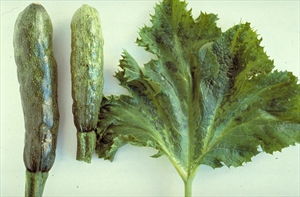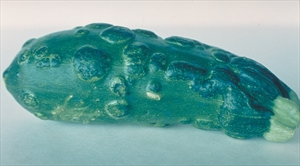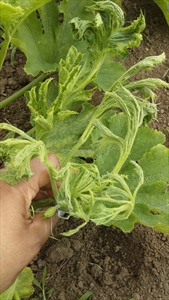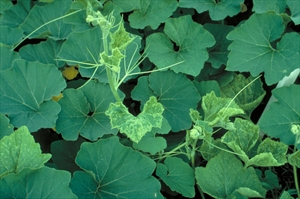Zucchini yellow mosaic
Pacific Pests, Pathogens and Weeds - Online edition
Pacific Pests, Pathogens & Weeds
Zucchini yellow mosaic (202)
Zucchini yellow mosaic virus, Zucchini yellow mosaic potyvirus. The virus exists as many strains.
Zucchini yellow mosaic virus is not alone in causing mosaics in zucchini and other cucurbits, there is Watermelon mosaic virus and Papaya ringspot virus type W. Watermelon mosaic virus causes mosaics (light and green patterns) on the leaves, whereas the other two distort both leaves and fruit. Cucumber mosaic virus also infects zucchini producing stunted distorted leaves, and surface roughness of the fruit.
Asia, Africa, North, South and Central America, Europe, Oceania. Zucchini yellow mosaic virus is recorded on cucurbits from Australia, Federated States of Micronesia, Fiji, French Polynesia, Guam, Nauru, New Caledonia, Northern Mariana Islands, Palau, Papua New Guinea, Samoa, Solomon Islands, Tonga, and Vanuatu.
Zucchini and other cucurbits, including melon, pumpkin, watermelon, as well as species of Luffa and Momordica.
A variety of symptoms are produced in cucurbits, including stunting, yellowing, mosaics (light and dark green patterns), and deformed leaves and fruits. For instance, zucchini typically show severe mosaics, usually with distortions and blisters, on the leaves and fruits (Photos 1-3&5). Often the plants fail to set fruits and those that develop are smaller than normal. On pumpkin, mosaics on the leaves are common (Photo 4).
ZYMV is spread by aphids; there are many species, although some species are more efficient than others. In the Pacific islands, the aphid, Aphis gossypii, is common and transmits the virus in a non-persistent way; this means that it acquires the virus on its mouthparts after a short feed on an infected plant (less than a minute), infects a healthy plant after another short feed, and then loses the ability to infect.
It is known that even aphids that do not colonise cucurbits easily transmit ZYMS; in some cases, they are more efficient in spreading the virus than those that do colonise cucurbits.
Zucchini yellow mosaic virus causes one of the most important virus diseases in many sub-tropical and tropical countries. It is probably the most common virus infecting cucurbits. In general, the effect on yield depends on the time of infection; with early infections of cucumber, melon and zucchini, complete loss is possible.
Look for the severe yellow and green patterns and distortions on the leaves, with blisters and other deformities on the fruits. However, these are not conclusive, and identification needs confirmation using serological or molecular methods. Other viruses, for example, Cucumber mosaic virus, Watermelon mosaic virus and the watermelon strain of Papaya ringspot virus (PRSV-W) can produce similar symptoms.
CULTURAL CONTROL
Before planting:
- Avoid growing overlapping crops, particularly when growing zucchini, otherwise aphids easily take the virus from old to young plants.
- Check each seedling for mosaic symptoms on the leaves before taking the plants to the field; discard any that show signs of the disease.
- Weed around the nursery, removing any weeds in the cucurbit family, e.g., the vine, Momordica charantia.
- Mild strain protection is used in some countries; using this technique plants are inoculated with a mild strain of ZYMV to protect them against more damaging strains. Ask your agricultural authorities about this.
During growth:
- Remove any weeds in the cucumber family from around cucurbit plantings, as well as any 'volunteer' (self-sown) plants.
- Restrict movement of people within the cucurbit plantings. Aphids can be taken into fields on people's clothes.
- Remove diseased plants as soon as symptoms are seen. Unfortunately, it is difficult to control ZYMV this way as the spread by aphids is so fast.
- Grow cucurbits under netting. This is very expensive and not a method for small-scale producers and subsistence growers. Also, the covers have to be removed to allow for pollination.
- Use plastic mulches (transparent or silver) as they have been shown to repel aphids and delay virus spread.
After harvest:
- Destroy all crop remains as soon as harvests have finished.
RESISTANT VARIETIES
There are resistant varieties in most cucurbit species, so growers should ask retailers if these are available. Some zucchini varieties tolerant to Papaya ringspot virus, Watermelon mosaic virus, and Zucchini yellow mosaic virus.
CHEMICAL CONTROL
Chemical control is not effective against this disease because aphids are able to transmit the virus so quickly. Usually, by the time the insecticide has killed the aphid, the aphid has fed and the virus has been transmitted. An exception to this are horticultural oils, either vegetable or petroleum based. Sprays of soaps, white oil (vegetable) or commercial horticultural oils (petroleum) may give some protection if applied frequently (see Fact Sheet no. 56). For instance:
White oil:
- 3 tablespoons (1/3 cup) cooking oil in 4 litres water.
- ½ teaspoon detergent soap.
- Shake well and use.
Soap:
- Use soap (pure soap, not detergent).
- 5 tablespoons of soap in 4 litres water, OR
- 2 tablespoons of dish washing liquid in 4 litres water.
Use commercial horticultural oils as indicated on the label. White oil, soap and horticultural oil sprays work by blocking the breathing holes of insects causing suffocation and death. They also stop some insects from feeding, without killing them. Spray the undersides of leaves; the oils must contact the insects.
____________________
When using a pesticide (or biopesticides), always wear protective clothing and follow the instructions on the product label, such as dosage, timing of application, and pre-harvest interval. Recommendations will vary with the crop and system of cultivation. Expert advice on the most appropriate pesticide to use should always be sought from local agricultural authorities.
AUTHOR Grahame Jackson
Information (and Photo 2) Diseases of vegetable crops in Australia (2010). Editors, Persley D, et al.. CSIRO Publishing; and from CABI (2014) Zucchini yellow mosaic. Crop Protection Compendium. (https://www.cabi.org/cpc/datasheet/57657). Photo 1 Kohler F, et al. (1997) Diseases of cultivated crops in Pacific Island countries. South Pacific Commission. Pirie Printers Pty Limited, Canberra, Australia. Photo 3 Semisi Pone, Auckland, New Zealand.
Produced with support from the Australian Centre for International Agricultural Research under project PC/2010/090: Strengthening integrated crop management research in the Pacific Islands in support of sustainable intensification of high-value crop production, implemented by the University of Queensland and the Secretariat of the Pacific Community.








